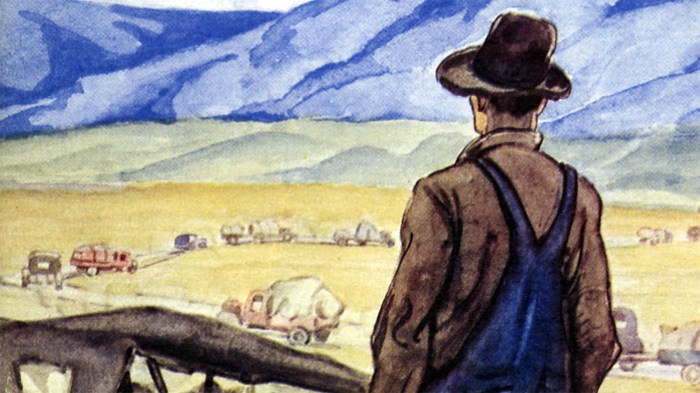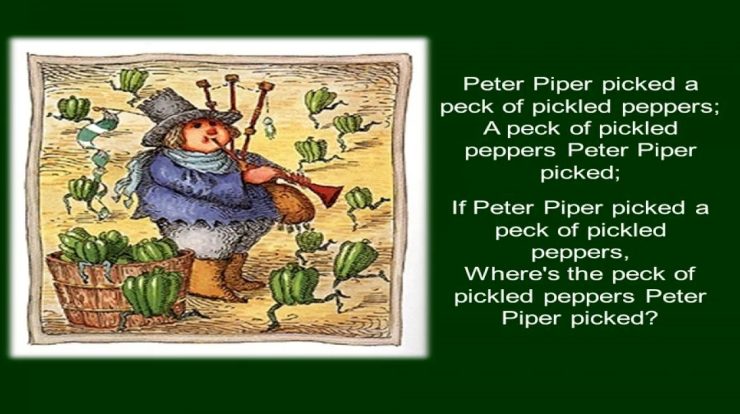Grapes of wrath chapter 15 – Embark on a captivating exploration of Chapter 15 in John Steinbeck’s masterpiece, Grapes of Wrath. This chapter unravels a tapestry of resilience and struggle, inviting readers to delve into the heart of the Great Depression era.
As Tom Joad’s journey continues, he encounters pivotal moments that shape his destiny. Jim Casy’s unwavering spirit and the Joad family’s unwavering bonds provide a beacon of hope amidst adversity.
Setting and Atmosphere: Grapes Of Wrath Chapter 15

Chapter 15 of “The Grapes of Wrath” is set in a squalid migrant camp in California. The camp is a collection of tents and shacks, set in a barren landscape. The atmosphere is one of poverty, desperation, and hopelessness.
The physical environment of the camp contributes to the overall atmosphere of the chapter. The tents and shacks are overcrowded and unsanitary, and the air is thick with dust and smoke. The migrants are living in squalor, and they are surrounded by the constant threat of disease and hunger.
Social Environment, Grapes of wrath chapter 15
The social environment of the camp is just as oppressive as the physical environment. The migrants are treated like outcasts by the local community, and they are constantly being exploited by the camp authorities. The migrants are forced to live in a state of constant fear and uncertainty, and they have no hope for a better future.
Character Development

In Chapter 15 of “The Grapes of Wrath,” significant developments occur in the characters of Tom Joad and Jim Casy, shaping their roles within the narrative.
Tom Joad
Tom’s journey in this chapter is marked by a growing awareness of his own potential and the power of collective action. Initially, he is hesitant to take on a leadership role within the migrant camp, fearing the consequences of his past actions.
However, as he witnesses the struggles and injustices faced by his fellow migrants, he realizes the importance of standing up for what is right.
Jim Casy
Jim Casy’s character undergoes a profound transformation in Chapter 15. After losing his faith in organized religion, he embraces a more spiritual and communal approach to life. He becomes a source of guidance and inspiration for the migrants, encouraging them to find strength and purpose in their collective struggle.
Themes

Chapter 15 of The Grapes of Wrathexplores several significant themes, including family and community, as well as social injustice and economic inequality.
Family and Community
The Joad family, at the center of the narrative, embodies the importance of family ties and community bonds. Despite the hardships they face, the family members remain fiercely loyal to each other, providing support and strength during their arduous journey.
The community of migrant workers also plays a vital role in the chapter. The workers share their meager resources, offer assistance to those in need, and provide a sense of belonging in the face of adversity.
Social Injustice and Economic Inequality
Chapter 15 vividly portrays the social and economic injustices faced by migrant workers during the Great Depression. The Joads and other families are exploited by ruthless landowners and employers, who pay them starvation wages and provide inadequate living conditions.
The chapter highlights the vast economic inequality between the wealthy landowners and the impoverished migrant workers, exposing the systemic flaws that perpetuate poverty and oppression.
Symbolism
The Grapes of Wrath, a potent symbol throughout the novel, hold profound significance in Chapter 15. These grapes, once a source of prosperity for the Joad family, now lie rotting on the vines, representing the shattered dreams and lost livelihoods of the migrant workers.
The fruit’s decay symbolizes the withering of hope and the despair that engulfs the Joads and their fellow travelers.
Dust Storms
The relentless dust storms that plague the land in Chapter 15 serve as a potent allegory for the suffocating oppression faced by the migrant workers. The choking dust, obscuring the horizon and blinding the travelers, parallels the societal and economic forces that conspire to crush their spirits.
The storms represent the relentless adversity that the Joads must endure, a constant reminder of their precarious existence.
Literary Techniques

Foreshadowing
Foreshadowing is used extensively in Chapter 15 of The Grapes of Wrath. Steinbeck plants several clues that hint at the hardships and dangers that lie ahead for the Joads.
In the heart-wrenching Grapes of Wrath Chapter 15, we witness the Joads’ relentless struggle against poverty and exploitation. Their plight resonates with the challenges faced by students seeking guidance on the NBME Psych Form 5. Fortunately, a lifeline exists at nbme psych form 5 answers , where experts provide comprehensive solutions.
Armed with this knowledge, we can return to the Joads’ story, inspired by their resilience and the hope that they, too, will find solace amidst adversity.
One example of foreshadowing is the description of the landscape. The chapter opens with a description of the “dry country” and the “gray hills” that the Joads are traveling through. This description foreshadows the harsh conditions that the Joads will face as they continue their journey.
Another example of foreshadowing is the encounter with the Wilsons. The Wilsons are a family who has lost everything, including their home and their children. Their story serves as a warning to the Joads of what could happen to them if they are not careful.
Imagery and Figurative Language
Steinbeck uses vivid imagery and figurative language throughout Chapter 15. This language helps to create a vivid and memorable picture of the Joads’ journey.
One example of imagery is the description of the Joads’ campsite. Steinbeck writes, “The camp was a ragged line of tents and shacks, strung out along the roadside like a string of beads.” This image helps to convey the sense of poverty and desperation that the Joads are experiencing.
Another example of figurative language is the simile that Steinbeck uses to describe the Joads’ journey. He writes, “The Joads were like ants, swarming out of the dust and crawling along the roadside.” This simile helps to convey the sense of insignificance and powerlessness that the Joads feel.
Comparison and Contrast

In Chapter 15 of The Grapes of Wrath, Tom Joad experiences a transformative journey that sets him apart from other characters in the novel. His encounters with the migrant community and the oppressive conditions they face shape his perspective and drive his subsequent actions.
Compared to other characters like Ma Joad, who maintains her unwavering determination and resilience, or Rose of Sharon, who embodies the strength and compassion of motherhood, Tom’s journey is marked by a growing sense of disillusionment and anger.
Similarities and Differences with Other Chapters
Chapter 15 shares similarities with earlier chapters in its depiction of the hardships faced by migrant workers. The Joads’ struggles to find work, their encounters with prejudice and exploitation, and their unwavering spirit are all recurring themes throughout the novel.
However, Chapter 15 stands out for its focus on Tom’s individual journey. While other chapters provide a broader perspective on the collective experience of the migrant community, this chapter delves deeply into Tom’s personal transformation and the choices he makes.
Detailed FAQs
What is the significance of the grapes in Chapter 15?
The grapes symbolize the unattainable dream of a better life for the migrant workers, highlighting the harsh realities of economic inequality.
How does Tom Joad evolve in this chapter?
Tom’s experiences in Chapter 15 deepen his understanding of social injustice and strengthen his resolve to fight for a better world.

